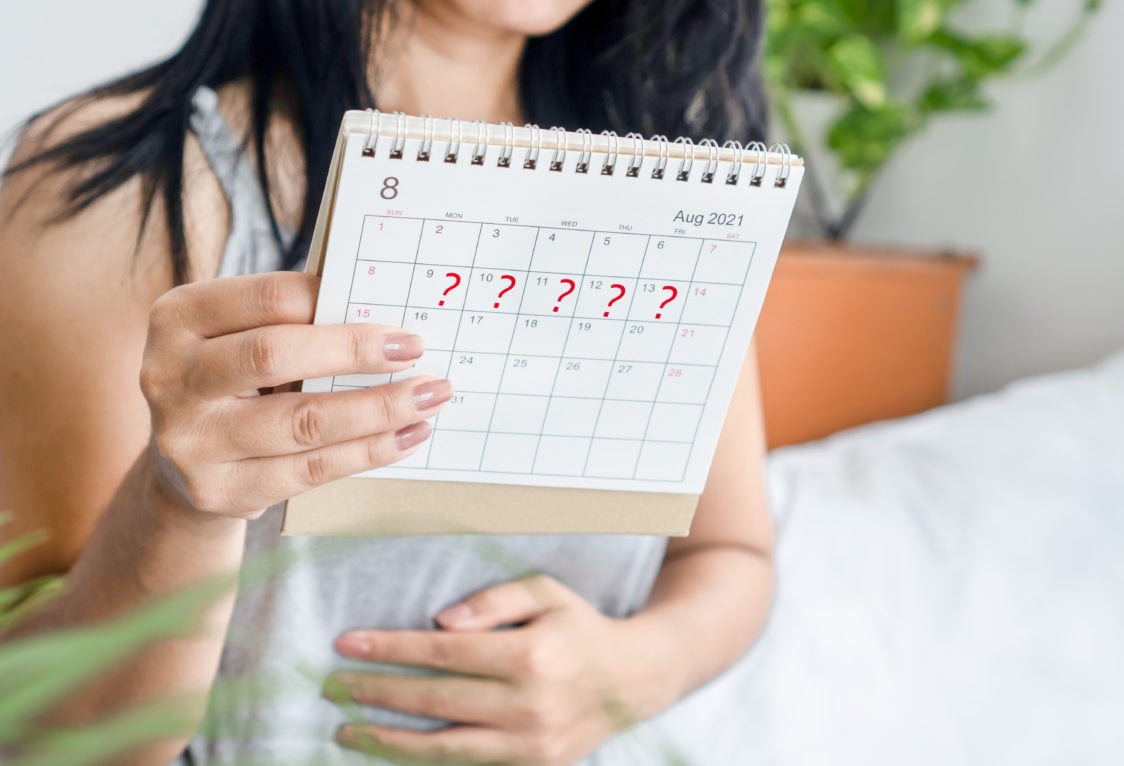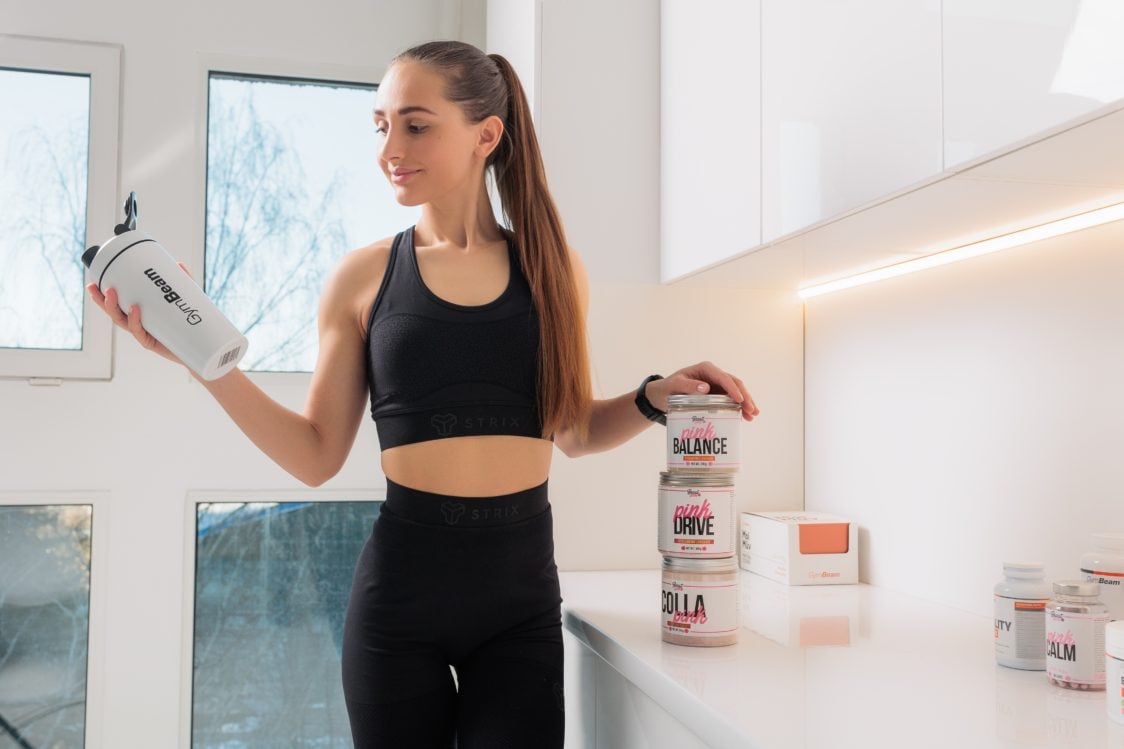Table of Contents
Many women struggle with the unpleasant symptoms of premenstrual syndrome (PMS) every month. Menstruation then closely follows on top of this, and so the wild rollercoaster ride of oestrogen and progesterone continues. During this period you may experience pain and cramps in the lower abdomen and back, heavy bleeding, fatigue or mood changes. All of this can interfere with managing daily responsibilities, reducing motivation to exercise, follow a diet, and achieve any other goals. Instead, you lie in front of the TV for X amount of hours, and the cheerful women in the sanitary products commercials seem out of this world.
What happens to the body during menstruation?
Hormones have the upper hand over your monthly cycle. These are mainly oestrogen and progesterone. Their levels change throughout the cycle and with it everything that happens in the body. It prepares for the eventual implantation of a fertilized egg and pregnancy. But if it doesn’t occur, the engorged uterine lining needs to be expelled from the body through menstruation. Unfortunately, this is often accompanied by unpleasant symptoms such as painful cramps, mood swings, increased fatigue and uncontrollable sweet cravings.
Menstruation typically lasts 3-8 days and it is possible to determine in advance when it will occur within a month. However, some women struggle with irregularity, skipped periods, or unpleasant symptoms that negatively affect their daily lives. [1]

What are the common symptoms of menstruation?
Menstrual symptoms and their intensity can vary. It is influenced by genetics, psychological factors, but also lifestyle. In addition to bleeding, these symptoms are also part of premenstrual syndrome (PMS). Some women experience them to the greatest extent as part of PMS. In this case, menstruation itself can paradoxically provide relief.
1. Bleeding
With the blood, the engorged uterine lining leaves the body. In the case of hormonal imbalance, when the mucous membrane grows to excessive thickness, bleeding can be stronger.
2. Pain in the lower abdomen and back
Here, substances called prostaglandins, which are produced by the uterine lining, are the most common culprit. They provoke contractions of the muscles of the uterus, which serves to expel its accrued layer. [2]
3. Mood changes
It’s probably a drop in serotonin that makes you feel like you’re on an emotional rollercoaster. This neurotransmitter is closely related to psyche and mood. Its levels usually rise and fall along with oestrogen, which is at low levels, especially just before and at the beginning of menstruation. [3]
4. Increased cravings for sweet and fatty foods
Low serotonin levels are probably responsible for the increased cravings for chocolate, biscuits, chips and other foods you crave on these days. It is linked to a reduced ability to induce a feeling of satiety. The brain may then urge you to eat more sugar and fat, which are rich in energy. [4]

5. Tiredness
Reduced serotonin levels or disturbed sleep are the most common causes of feeling more tired during this period. During PMS and the first days of menstruation, you may have difficulty sleeping undisturbed for long enough due to abdominal pain and mental discomfort. [5]
Do you suffer from frequent fatigue and don’t know how to deal with it? Perhaps our article may help Why Are You Always Tired? The 7 Most Common Causes and Their Solutions.
6. Breast pain and tenderness
Oestrogen and progesterone cause enlargement of the mammary glands and ducts, which can then manifest itself not only in larger breasts, but also in pain and tenderness. [6]
7. Acne and other skin symptoms
While oestrogen and progesterone levels fluctuate at low levels during menstruation, testosterone remains almost unchanged throughout the cycle. At certain times, it can become more pronounced than usual, causing, for example, pimples and a worsened appearance of the skin. [7]
8. Bloated abdomen and other digestive problems
High levels of prostaglandins can also affect bowel function, aiding increased contraction of the muscles of the digestive tract. This can manifest itself in a distended abdomen, constipation, but also in more frequent visits to the toilet. [8]
If you are wondering what else can cause a bloated belly, read our article Why Do You Suffer from a Bloated Belly and How to Get Rid of It?
9. Water retention
During PMS and the first few days of menstruation, your body weight can increase slightly, even by several kg. This is largely due to increased water retention caused by hormonal changes. With each day of menstruation, the amount of water retained gradually returns to normal. [9]
If you’re wondering what else could be behind your weight gain, read our article Why the Scale Is Showing You a Higher Number and It’s Not Fat.

What can cause painful menstruation?
Pain in the lower abdomen and back is experienced by most women during PMS and the first days of menstruation. As a rule, it is bearable and women take it as a normal part of the period. But some women experience pain and cramps of such intensity that they have trouble coping with everyday life. This condition is medically referred to as dysmenorrhoea and is often accompanied by headaches, dizziness nausea or vomiting. [2]
What are the most common causes of menstrual pain or dysmenorrhoea?
Finding the specific cause of painful menstruation is sometimes quite a challenge. The best advice is given by a doctor (gynaecologist), who will carry out a specialist examination and, based on this, can make a diagnosis and possible solution. But there are causes that are more common in women with dysmenorrhoea. [10]
1. Primary dysmenorrhoea
In this case, cramps appears just before and at the beginning of menstruation. It is mainly caused by prostaglandins, which are formed in the uterine mucosa. These substances provoke contractions of the muscles and vessels of the uterus. Their levels typically decrease with each day of menstruation, and so does the perceived pain. [2]
2. Secondary dysmenorrhoea
This type differs not only in the cause, but also in the nature of the pain. It can gradually worsen over time and usually lasts longer than normal menstrual pain. The most common source of this trouble is ongoing disease of the reproductive organs. These include endometriosis, where parts of the uterine lining are outside the organ. Then there is also PCOS, or polycystic ovary syndrome. The latter is related to hormonal imbalance and commonly manifests itself as a disruption in the course of menstruation. It can also be the cause of difficulties in getting pregnant. [11]
If you want to learn more about PCOS, read our article PCOS – A Syndrome Every Woman Should Know About.
You might be interested in these products:
9 ways to relieve heavy and painful menstruation
There are a number of methods to better manage painful menstruation (primary dysmenorrhoea). You can then find the one that suits you best. You don’t have to worry about some shamanic rituals or drinking magic potions from Hogwarts. These are simple and completely natural changes in everyday life, but they can bring about great results in the form of relieving painful menstruation. And maybe, thanks to them, you won’t have to take ibuprofen and other painkillers anymore.
1. Try some light exercise
Usually in the first days of menstruation, when the pain is the most intense, you are drawn to the couch rather than to the gym. You just don’t think about lifting heavy weights, HIIT or hard cardio. But what about trying yoga, stretching, light jogging or even a walk? Low-intensity activities can help you to get better blood flow throughout the body, relax the muscles in the pelvic area and, most importantly, flush out endorphins. Beta-endorphin in particular has analgesic effects in addition to its positive effect on mood. It can thus help you to reduce perceived pain. In addition, it can reduce appetite, which can also come in handy during these days. [12-13]
- The positive effects of regular exercise on reducing menstrual pain have also been confirmed in a number of studies.
- Participants exercised 2-3 times a week for 45-60 minutes.
- The most common were light aerobic activities such as running, dancing or fast walking, as well as yoga or isometric exercises.
- Physical activity generally led to a decrease in the use of painkillers and less frequent absenteeism from work or school due to menstrual pain. [12-13]

2. Warm yourself completely
The use of heat is one of the most well-known methods for pain relief. It releases muscle tension, relaxes the abdominal muscles and increases blood circulation in the pelvis. This allows to get rid of local engorgement and swelling, which is a common cause of pain caused by nerve compression. Traditionally, heated towels, warm gel packs, hot water bottle or warm showers are used. A sauna can also help with mild pain if hygiene precautions are taken. [14]
If you are wondering how to use a sauna properly and what it can do for you besides relieve your pain, read our article Sauna and Health: The Correct Procedure, Benefits and Effects on the Body.
3. Get plenty of sleep and rest
Hormonal changes and painful cramps during menstruation can also disrupt sleep. Lack of sleep then leads to fatigue, which in turn contributes to poorer coping with menstrual symptoms. In the long term, poor sleep quality can even lead to irregular periods.
How to sleep better while menstruating?
- In the afternoon and evening, it is advisable to limit your intake of coffee and other caffeinated beverages, alcohol and foods high in fat and calories.
- Avoid using your phone, computer and watching TV before bed. Alternatively, you can use a blue light filter on these devices.
- Light stretching or yoga just before bed helps to reduce muscle tension, making the whole body more relaxed.
- A regular evening routine gets you ready for bed. You can take a warm shower before going to bed, then create a pleasant atmosphere in your room and air it out properly. Then, to calm the body, you can listen to relaxing music, read a book and sip herbal tea or hot cocoa with maca.
- A heated hot water bottle can help relieve abdominal pain, as can the position in which you lie. The ideal position is the foetal position where you lie on your side, pull your knees to your abdomen and hug them with your arms. This will reduce tension on the abdominal muscles. [15-16]
If you’re having trouble falling asleep, you might also find our other tips for falling asleep faster and getting a better quality sleep useful in our article How to Fall Asleep Quickly? Try Our Simple Tips for a Better Sleep.

4. Limit your alcohol intake
At this time, when you are not exactly emotionally stable, you may think of looking for a solution at the bottom of a glass of wine. Alcohol can help switch off for a while, relax and dull the pain a little. But then, as a rule, sobriety sets in with even worse menstrual symptoms and a slight hangover on top. It also brings dehydration, which can cause thickening of the menstrual blood. This makes it more difficult for the uterine lining to shed, causing even more pain and cramping in the lower abdomen. In addition, alcohol can increase the levels of oestrogen and testosterone in your body. This can then manifest itself in even more mood swings, irritability and worsening of other PMS and menstrual symptoms. [17]
- Before the start of menstruation and in the first few days, it is advisable to avoid your favourite alcoholic drink and focus on drinking water and other non-alcoholic beverages.
- Water should make up the majority of your daily fluid intake.
- You can diversify your water intake with a caffeine-free drink with BCAAs, zinc and vitamins, tea or flavour water with lemon, mint and other herbs.
- In a given day you should drink 30 – 45ml of water per kg of body weight.
5. Watch out for excess sugar and salt in food
A piece of chocolate, a couple of biscuits or a portion of home-made dessert can make these difficult days better. But eating sweets for breakfast, lunch and dinner is not such a good idea. High sugar intake may increase the risk of painful menstruation, according to studies. If you prefer salty treats like chips or salted nuts to sweet, you’re not much better off either. These foods are high in salt, which in excessive amounts can cause a bloated belly and also water retention in the body. You already struggle with these symptoms during PMS and menstruation, so it doesn’t pay to risk making them worse. [18]

What should you eat during menstruation?
- Throughout the day, try to add protein (meat, dairy, fish, tofu or protein) to every meal, which has a high satiating power. This way you won’t be craving a dessert or an extra snack after the meal.
- Complex carbohydrates, such as oats, whole grain bread, quinoa or rice, should not be not left out of your meals. This way, you get fibre, which also makes you feel fuller, so you don’t want to make up for your carbohydrate intake with sugary treats.
- You shouldn’t forget about healthy fats either. Oil, nuts or seeds give you energy and food containing them is also more satiating.
- During the day, add a portion of fruit or vegetables to every meal. These superfoods provide necessary vitamins, minerals and fibre that are important for healthy digestion.
- It is better to replace milk chocolate or other sweets with, for example, a piece of high-quality dark chocolate, which can be supplemented with fruit or nuts, or added to porridge with protein. You will get a complete meal and will not have such a strong urge to eat a whole bar of chocolate.
- Keep an eye on the amount of salt in your food and try to find lower salt options. It is ideal to prepare food at home, as this way you can better control the amount of salt used. For seasoning, it is advisable to use herbs, garlic and other spices without added salt.
- Probiotic foods such as yoghurt, kefir milk, kimchi, sauerkraut, tempeh or kombucha can also support proper digestion. [19]
Comprehensive advice and recommendations for healthy eating can be found in our article What Is a Healthy Diet and How to Learn to Eat Healthily?
6. Manage your intake of important vitamins
Adequate intake of all vitamins is key to maintaining your health. They also play an important role in the menstrual cycle and its smooth progress. According to several studies, some of them may even help to alleviate the symptoms of PMS and menstruation.
What vitamins can affect the menstrual cycle, according to scientific studies?
- Vitamin B1 can reduce the symptoms of PMS and its supplementation has been shown to be effective in women with painful and heavy menstrual periods. [20]
- Vitamin B6 is important for the production of the neurotransmitters dopamine and serotonin. These substances are closely related to mood and can regulate feelings of anxiety and appetite. Dopamine is also associated with feelings of contentment and happiness. [21]
- Vitamin D is crucial not only in terms of immunity and calcium absorption. It also contributes to the maintenance of regular menstruation and its smooth progress. In addition, it affects hormonal health and low levels are found in women with PCOS. [22]

7. Magnesium, calcium, zinc and omega 3
Minerals and healthy fats in the form of omega-3 fatty acids also contribute to the proper functioning of the female body. A deficiency of these is often found in women with PMS and dysmenorrhoea. For this reason, scientists have set out to investigate the effect of these substances on the physical and psychological manifestations of the menstrual cycle. Based on studies, they have discovered their beneficial effects.
- Magnesium can alleviate the symptoms of PMS and menstruation, especially thanks to its relaxing effects on the nervous system and muscles. It can help relieve muscle tension in the uterine area, thus easing painful cramps. It is often combined with vitamin B6 in dietary supplements. In this combination, it has been shown to have an effect on relieving unwanted menstrual symptoms such as water retention, abdominal pain and anxiety. [23]
- Calcium has also proven useful for women who have had unpleasant symptoms of PMS and menstruation. It was able to reduce water retention, appetite and pain that occurs during this phase of the cycle. [24]
- Omega 3 fatty acids can contribute to the regularity of the menstrual cycle. Its supplementation has also been shown to be effective in women with PCOS. [25]
- Zinc can reduce the production of prostaglandins, which are the main culprit of abdominal cramps. In addition, it is known for its positive effects on reproductive function. [26]
- Chromium helps to regulate blood sugar levels in the body, which helps to suppress uncontrollable sweet cravings. For this reason, it is a popular ingredient in appetite-reducing dietary supplements such as Appetite Control. [27]

9. Try the power of herbs
Herbs can also help you get through this difficult period more easily. A number of them have been shown in studies to help with irregular and painful menstruation. They have a calming effect and can act in the body in a similar way to the happiness hormone dopamine. And you can never have enough of that during your time of the month. In addition, they can help to regulate your upset digestion and rid of a bloated belly. [28-29]
The most commonly used herbs to relieve the symptoms of PMS and menstruation
- Chamomile (Matricaria chamomilla)
- ginger (Zingiber officinale)
- Fennel (Foeniculum vulgare)
- lady’s mantle (Alchemilla vulgaris)
- chaste tree (Vitex agnus castus)
A different herb may suit and work for each of you. You can find them in tea or dietary supplements. [28-29]
9. Try complex dietary supplements
Dietary supplements for women, such as Pink Balance, combine the power of vitamins, minerals and plant extracts. Thanks to their complex ingredients profile, they can then target a wide range of unpleasant symptoms of PMS and menstruation. Pink balance is also ideal for women with PCOS, irregular and painful cycles. It will also be appreciated by ladies and women who do not have these problems, but just want to feel a little better during their period. The contained substances have a beneficial effect on the psyche and reproductive functions and help with the correct course of the key phases of the cycle.
In addition to the aforementioned zinc, fennel or fennel extract, there are other active ingredients in this supplement. For example, myo-inositol is a vitamin-like molecule that is used in the treatment of PCOS. According to experts who have researched this substance, it can also increase serotonin levels. This is probably why myo-inositol is so often associated with better mood and anxiety relief. Vitamin B9 (folic acid) it contains helps to reduce fatigue and exhaustion, which is especially helpful on days when you feel generally lacking in energy. Additionally, alpha lipoic acid (ALA) contributes to supporting glycaemic levels, which can help reduce sweet cravings.

What should you remember?
All the mental and physical symptoms that you experience during menstruation can not only torment you, but sometimes even your loved ones. Luckily, there are ways to ease them and get through those tough days a little easier.
First of all, you can try to incorporate a few lifestyle changes. Light physical activity such as yoga or walking can relieve pain and tension in the lower abdomen and back. Making the right food choices can help tame sweet cravings and relieve bloating or other digestive problems. It is also advisable to focus on getting enough sleep, which will give you the energy to better cope with these days. All of this can then be supported with an intake of selected vitamins, minerals or herbs. For example, you can reach for complex dietary supplements such as Pink Balance, which is designed to meet the needs of the female body.
If you liked our article and learnt new information, please share it with your friends. They will be happy to learn how to better manage PMS and painful menstrual symptoms.
[1] Menstrual cycle—Better Health Channel. – https://www.betterhealth.vic.gov.au/health/conditionsandtreatments/menstrual-cycle
[2] ACOG. Dysmenorrhea: Painful Periods. – https://www.acog.org/en/womens-health/faqs/dysmenorrhea-painful-periods
[3] PMS Emotions: Mood Swings In Women During Period. EverydayHealth.Com. – https://www.everydayhealth.com/pms/mood-swings.aspx
[4] Psychology Today. Serotonin: What It Is and Why It’s Important for Weight Loss.– https://www.psychologytoday.com/us/blog/the-antidepressant-diet/201008/serotonin-what-it-is-and-why-its-important-weight-loss
[5] Period fatigue: Treatment, causes, and prevention. – https://www.medicalnewstoday.com/articles/period-fatigue
[6] Breast Tenderness Before Period: Why It Happens and How to Reduce the Pain. – https://flo.health/menstrual-cycle/health/period/breast-tenderness-before-period
[7] Period Acne: Causes, Types, and Treatment of Menstruation Acne. Mobile Product for Women’s Health. – https://flo.health/menstrual-cycle/health/period/period-acne
[8] Dr. Jolene Brighten. How Prostaglandins Cause Painful Periods + What to Do About It. – https://drbrighten.com/how-prostaglandins-cause-painful-periods-what-to-do-about-it/
[9] Creekside Center For Women. Water retention: Relief for this Premenstrual Symptom. – https://creeksideobgyn.com/water-retention/
[10] Osayande, A. S., & Mehulic, S. Diagnosis and Initial Management of Dysmenorrhea. – https://www.aafp.org/afp/2014/0301/p341.html
[11] Northside Gynaecology. What are periods like when you have PCOS? – https://www.northsidegynaecology.com.au/what-are-periods-like-when-you-have-pcos/
[12] Cochrane. Exercise for dysmenorrhoea. – https://www.cochrane.org/CD004142/MENSTR_exercise-dysmenorrhoea
[13] Purwanti, N., Wijayanti, L., & HelmiSetiawan, A. (b.r.). EFFECT OF AEROBIC EXERCISE ON MENSTRUAL PAIN. 6. – http://eprints.ners.unair.ac.id/382/3/EFFECT%20OF%20AEROBIC%20EXERCISE%20ON%20MENSTRUAL%20PAIN.pdf
[14] Jo, J., & Lee, S. H. Heat therapy for primary dysmenorrhea: A systematic review and meta-analysis of its effects on pain relief and quality of life. – https://doi.org/10.1038/s41598-018-34303-z
[15] D. S. J. M. How does your period impact your sleep? – https://patient.info/news-and-features/how-does-your-period-impact-your-sleep
[16] SleepScore. 7 Ways to Get Better Sleep While on Your Period. – https://www.sleepscore.com/blog/7-ways-to-get-better-sleep-while-on-your-period/
[17] Alcohol and Period: Surprising Truth about Drinking on Your Period. – https://flo.health/menstrual-cycle/health/period/alcohol-and-period
[18] Peng, A. W., Juraschek, S. P., Appel, L. J., Miller, E. R., & Mueller, N. TEffects of the DASH Diet and Sodium Intake on Bloating: Results From the DASH-Sodium Trial. – https://doi.org/10.14309/ajg.0000000000000283
[19] Bavil, D. A., Dolatian, M., Mahmoodi, Z., & Baghban, A. A. Comparison of lifestyles of young women with and without primary dysmenorrhea. – https://doi.org/10.19082/2107
[20] The Effects of Vitamin B1 on Ameliorating the Premenstrual Syndrome Symptoms—PMC. – https://www.ncbi.nlm.nih.gov/pmc/articles/PMC4825494/
[21] Soheila, S., Faezeh, K., Sayehmiri, K., Fatemeh, S., Nasrollah, N., Mahin, G., Asadi-Samani, M., & Bahmani, M. Effects of vitamin B6 on premenstrual syndrome: A systematic review and meta-Analysis. – https://www.researchgate.net/publication/309104863_Effects_of_vitamin_B6_on_premenstrual_syndrome_A_systematic_review_and_meta-Analysis
[22] Łagowska, K.. The Relationship between Vitamin D Status and the Menstrual Cycle in Young Women: A Preliminary Study. – https://doi.org/10.3390/nu10111729
[23] Fathizadeh, N., Ebrahimi, E., Valiani, M., Tavakoli, N., & Yar, M. H. Evaluating the effect of magnesium and magnesium plus vitamin B6 supplement on the severity of premenstrual syndrome. – https://www.ncbi.nlm.nih.gov/pmc/articles/PMC3208934/
[24] Calcium reduced PMS symptoms during the luteal phase of the menstrual cycle. – https://ebn.bmj.com/content/2/2/43
[25] Maarouf, T., Mohamed, D., Tantawy, A. A., & Eid, P. M. Effect of Omega-3 Fatty Acids on Hormonal Profile and Ovarian Stromal Blood Flow in Patients with Polycystic Ovary Syndrome. Evidence Based Women’s Health Journal. – https://doi.org/10.21608/ebwhj.2019.64357
[26] Eby, G. A. Zinc treatment prevents dysmenorrhea. – https://doi.org/10.1016/j.mehy.2006.12.009
[27] Frank, K., Patel, K., Lopez, G., & Willis, B. Chromium Research Analysis. – https://examine.com/supplements/chromium/
[28] Integrating life-style focused approaches into the management. – https://www.dovepress.com/integrating-lifestyle-focused-approaches-into-the-management-of-primar-peer-reviewed-fulltext-article-IJWH
[29] Cummings, G. 10 common digestive herbs and their health benefits. – https://www.standard.co.uk/reveller/foodanddrink/10-common-digestive-herbs-and-how-they-benefit-your-health-a3624266.html

